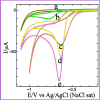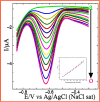Beyond templates: exploring uncharted territory in anisotropic gold nanostructure-oligomer composites synthesis and electrocatalytic performance towards environmental pollutants
- PMID: 39717817
- PMCID: PMC11664328
- DOI: 10.1039/d4ra07744j
Beyond templates: exploring uncharted territory in anisotropic gold nanostructure-oligomer composites synthesis and electrocatalytic performance towards environmental pollutants
Abstract
The synthesis of polymer/oligomer-stabilized metal nanostructures (MNS) opens up a wide range of possibilities, from fundamental materials science to practical applications in domains such as medicine, catalysis, sensing, and energy. Because of the versatility of this synthetic approach, it is a dynamic and ever-changing field of study. These polymers/oligomers have precise control over the nucleation and growth kinetics, allowing the production of mono-disperse MNS with well-defined properties. The protective coating provided by polymers or oligomers increased the stability and colloidal dispersity of MNS in these oligomer-MNS composites. As a result, the current research reports the electrocatalytic reduction of nitrobenzene (NB) utilizing oligomeric aminomercaptotriazole (oligo AMTa) and oligo (AMTa-AuNS) modified glassy carbon (GC) electrodes developed via a wet chemical technique. UV-visible spectroscopy, Fourier-transform infrared spectroscopy (FT-IR), X-ray photoelectron spectroscopy (XPS), high resolution mass spectroscopy (HR-MS), and high-resolution transmission electron microscopy (HR-TEM) approaches were used to confirm the development of oligomer and AuNS. After that, the GC electrode was directly linked to the oligo AMTa and oligo AMTa-AuNS by dipping them in the appropriate solutions. Scanning electron microscopy (SEM), electrochemical impedance spectroscopy (EIS), and cycle voltammetry (CV) were all employed to confirm the fabrication of oligo AMTa and oligo AMTa-AuNS. Eventually, the electrochemical reduction of NB occurred using the fabricated electrodes. The catalytic activity of oligo AMTa-AuNS has been observed to be more than that of the other modified electrode. As an outcome, the film was employed to determine the sensitivity level of NB, and a limit of detection (LOD) of 2.8 nM was found. The straight-forward method's practical utility was proven by measuring NB in lake sample water.
This journal is © The Royal Society of Chemistry.
Conflict of interest statement
There are no conflicts to declare.
Figures










Similar articles
-
Exploring Electrochemical Sensing for Fungicide Detection: Utilization of Newly Synthesized Oligomers.ACS Omega. 2024 Aug 16;9(34):36622-36634. doi: 10.1021/acsomega.4c04959. eCollection 2024 Aug 27. ACS Omega. 2024. PMID: 39220534 Free PMC article.
-
Improved conductivity of flower-like MnWO4 on defect engineered graphitic carbon nitride as an efficient electrocatalyst for ultrasensitive sensing of chloramphenicol.J Hazard Mater. 2020 Nov 15;399:122868. doi: 10.1016/j.jhazmat.2020.122868. Epub 2020 May 19. J Hazard Mater. 2020. PMID: 32531674
-
Direct Electrochemical DNA Sensor based on a new redox oligomer modified with ferrocene and carboxylic acid: Application to the detection of Mycobacterium tuberculosis mutant strain.Anal Chim Acta. 2017 Nov 22;994:10-18. doi: 10.1016/j.aca.2017.09.022. Epub 2017 Sep 22. Anal Chim Acta. 2017. PMID: 29126464
-
Development of novel microsphere structured - calcium tungstate as efficacious electrocatalyst for the detection of antibiotic drug nitrofurantoin.J Mater Chem B. 2023 Dec 13;11(48):11600-11611. doi: 10.1039/d3tb02087h. J Mater Chem B. 2023. PMID: 38037876
-
Biosynthesis of silver nanoparticles by using Camellia japonica leaf extract for the electrocatalytic reduction of nitrobenzene and photocatalytic degradation of Eosin-Y.J Photochem Photobiol B. 2017 May;170:164-172. doi: 10.1016/j.jphotobiol.2017.03.018. Epub 2017 Mar 28. J Photochem Photobiol B. 2017. PMID: 28433872
References
-
- George J. M. Antony A. Mathew B. Metal oxide nanoparticles in electrochemical sensing and biosensing: a review. Microchim. Acta. 2018;185:358. - PubMed
-
- Amirjani A. Rahbarimehr E. Recent advances in functionalization of plasmonic nanostructures for optical sensing. Microchim. Acta. 2021;188:57. - PubMed
-
- John A. Benny L. Cherian A. R. Narahari S. Y. Varghese A. Hegde G. Electrochemical sensors using conducting polymer/noble metal nanoparticle nanocomposites for the detection of various analytes: a review. J. Nanostruct. Chem. 2021;11:1.
-
- Sajanlal P. R. Sreeprasad T. S. Nair A. S. Pradeep T. Wires, plates, flowers, needles, and core–shells: diverse nanostructures of gold using polyaniline templates. Langmuir. 2008;24:4607. - PubMed
-
- Kyomuhimbo H. D. Feleni U. Catalytic and energy storage applications of metal/polyaniline nanocomposites: a critical review. J. Electron. Mater. 2022;51:5568.
LinkOut - more resources
Full Text Sources
Research Materials
Miscellaneous

